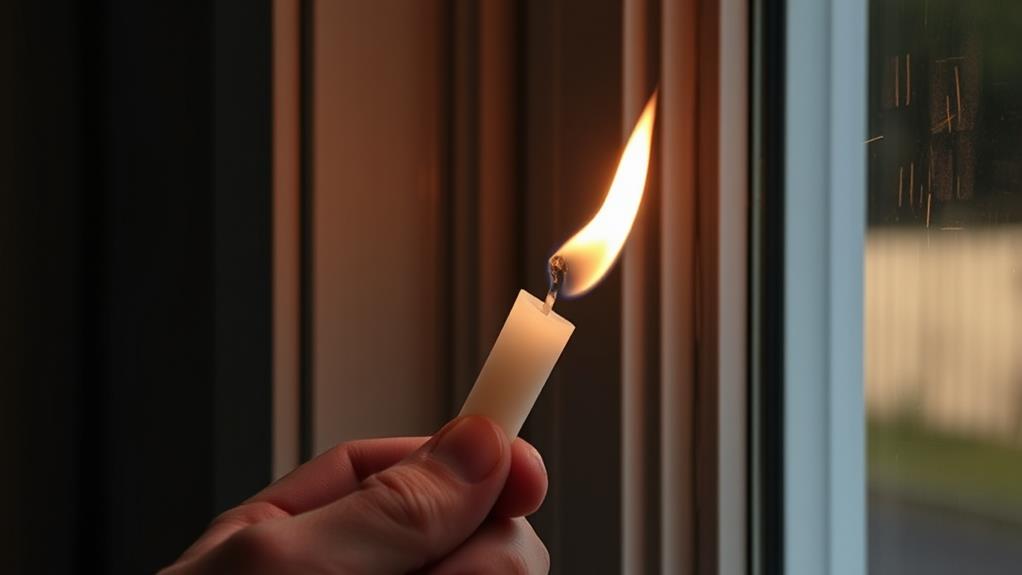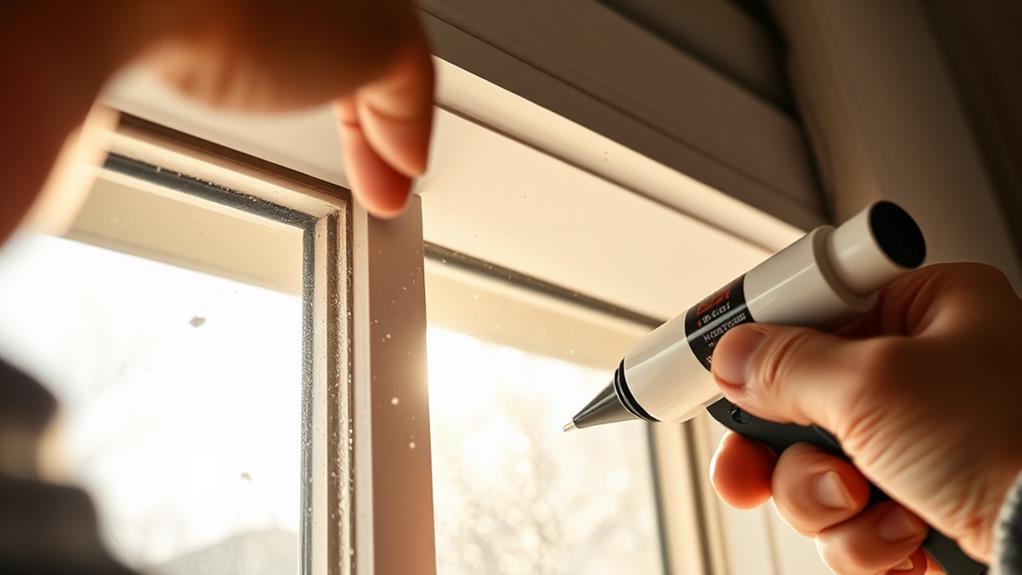To properly seal windows and doors, start by identifying draft sources using visual inspection or simple tests like the dollar bill method. Apply weather stripping to window frames and door edges, ensuring a snug fit. Caulk gaps around window frames and use door sweeps to block under-door drafts. Install foam tape on door frames for an extra barrier. Consider using window film insulation for added protection. Don't forget to seal less obvious areas like electrical outlets and switch plates with foam gaskets. By addressing these key points, you'll significantly reduce energy loss and improve your home's comfort. There's more to explore for maximum draft-proofing effectiveness.
Identify Sources of Drafts

Before you start sealing, it's crucial to pinpoint where drafts are entering your home. Begin by visually inspecting your windows and doors for obvious gaps or cracks. Pay special attention to the areas where different materials meet, such as where the window frame meets the wall or where door panels join.
Next, use your hand to feel for air movement around the edges of windows and doors. On a windy day, this method can be particularly effective. For a more precise approach, light an incense stick and slowly move it along the perimeters of your windows and doors. Watch for smoke that's blown horizontally or sucked towards the opening, indicating a draft.
Another useful technique is the dollar bill test. Close a dollar bill in the door or window; if you can easily pull it out, there's likely a draft. Don't forget to check less obvious areas like electrical outlets, switch plates, and baseboards. These can also be sources of air leaks. By thoroughly identifying all draft sources, you'll be better prepared to effectively seal your windows and doors.
Weather Stripping for Windows
Weather stripping is one of the most effective ways to seal your windows against drafts. It's a flexible material that fills the gaps between movable parts of windows, preventing air leakage. You'll find various types of weather stripping, including adhesive-backed foam tape, V-strip, and tubular gasket.
To install weather stripping, first clean the window frame thoroughly. Measure the perimeter of the window and cut the stripping to size. For adhesive-backed foam tape, simply peel off the backing and press it firmly into place along the frame. V-strip weather stripping requires you to nail or staple it into the frame. Tubular gasket types often come with a flange for easy installation.
Pay special attention to the bottom of the window sash, where drafts are most common. You might need to use a different type of weather stripping here, such as a sweep or brush seal. Don't forget to check for proper window operation after installation. If the window doesn't close easily, adjust or trim the weather stripping as needed. Replace worn-out weather stripping every few years to maintain its effectiveness in blocking drafts.
Caulking Window Frames

While weather stripping tackles gaps in movable parts, caulking addresses the stationary areas of your window frames. It's essential to seal these gaps to prevent air leaks, moisture infiltration, and energy loss. Before you begin, clean the area thoroughly and remove any old caulk.
Choose a high-quality, exterior-grade caulk that's compatible with your window materials. Silicone caulk is durable and flexible, while acrylic latex is easier to work with and paintable. Cut the caulk tube's nozzle at a 45-degree angle, making a hole that matches the gap size.
Apply the caulk in a smooth, continuous bead along the joint between the window frame and the house siding. Use steady pressure on the caulk gun and maintain a consistent angle. For best results, caulk on a dry day when temperatures are above 40°F (4°C).
Smooth the caulk immediately after application using a wet finger or a caulk-smoothing tool. This ensures proper adhesion and a neat appearance. Remove any excess caulk with a damp cloth. Allow the caulk to dry completely before painting, if necessary. Regularly inspect and maintain your caulking to ensure continued effectiveness in sealing your windows.
Door Sweeps and Thresholds
The gap beneath your door can be a major source of drafts and energy loss. To combat this, you'll need to install door sweeps and thresholds. Door sweeps are strips of material attached to the bottom of the door, while thresholds are installed on the floor beneath the door.
To install a door sweep, measure the width of your door and cut the sweep to fit. Remove the door from its hinges and attach the sweep using screws or adhesive. Make sure it's positioned correctly to create a tight seal when the door is closed.
For thresholds, measure the width of your doorway and choose a threshold that matches. Remove any existing threshold and clean the area. Apply caulk to the bottom of the new threshold and secure it with screws. Ensure it's level and forms a tight seal with the door sweep.
You can also use weatherstripping around the sides and top of the door frame for additional insulation. Choose self-adhesive foam or rubber strips and cut them to fit. Clean the frame surface before applying the weatherstripping to ensure proper adhesion.
Foam Tape for Doors

Offering a quick and easy solution for sealing doors, foam tape provides an effective barrier against drafts and energy loss. You'll find this self-adhesive weatherstripping in various thicknesses and widths at most hardware stores.
To apply foam tape, start by cleaning the door frame thoroughly and ensuring it's dry. Measure the length of each side of the frame and cut the tape to fit.
Peel off the backing and carefully press the tape onto the frame, making sure it's aligned properly. Pay special attention to corners and joints, as these are common areas for air leaks. For best results, apply the tape to the side of the frame that the door presses against when closed.
While foam tape is easy to install, it's not as durable as some other weatherstripping options. You may need to replace it every few years, especially in high-traffic areas. However, its affordability and ease of installation make it a popular choice for many homeowners.
For optimal performance, combine foam tape with other sealing methods, such as door sweeps or adjustable thresholds, to create a comprehensive draft-proofing solution for your doors.
Window Film Insulation
Insulating window film offers an affordable and non-invasive way to boost your home's energy efficiency. This transparent plastic film creates an extra layer of insulation when applied to your windows, helping to keep warm air inside during winter and cool air inside during summer.
To install window film, you'll need to clean your windows thoroughly and measure them carefully. Cut the film slightly larger than the window frame, then apply it using double-sided tape or the adhesive that comes with the kit. Use a hair dryer or heat gun to shrink the film, creating a tight seal.
Window film insulation is particularly useful for older, single-pane windows or in rental properties where you can't make permanent changes. It's easy to remove at the end of the season, leaving no residue behind. While not as effective as replacing windows entirely, this method can still reduce heat loss by up to 50%.
Remember to choose high-quality film for better durability and clarity. Some films even offer UV protection, which can help prevent furniture fading. For best results, apply the film to both the inside and outside of your windows.
Outlet and Switch Plate Gaskets

While window insulation tackles large drafty areas, it's easy to overlook smaller sources of air leakage. One often-neglected spot is your electrical outlets and switch plates. These openings in your walls can allow cold air to seep in, compromising your home's energy efficiency.
To address this issue, install outlet and switch plate gaskets. These thin foam inserts fit snugly behind the cover plates, creating a barrier against drafts. You can find them at most hardware stores or online retailers. To install, simply remove the cover plate, place the gasket over the outlet or switch, and reattach the cover.
For added protection, consider using child safety plugs in unused outlets. These not only prevent curious fingers from exploring but also block air infiltration. In older homes with particularly drafty outlets, you might want to use a foam sealant around the electrical box before installing the gasket.
Don't forget about outlets on exterior walls, as these are more prone to air leakage. By addressing these small gaps, you'll notice a significant improvement in your home's overall insulation and comfort levels, potentially reducing your energy bills in the process.
Professional Energy Audit Options
Sometimes, despite your best DIY efforts, you might wonder if you've overlooked any energy-saving opportunities in your home. That's where a professional energy audit comes in handy. These experts use specialized tools and techniques to identify areas of energy loss and inefficiency.
During an audit, professionals typically perform a blower door test to measure air leakage and use infrared cameras to detect temperature differences that indicate insulation gaps. They'll inspect your HVAC system, windows, doors, and attic space for potential improvements. You'll receive a detailed report outlining their findings and recommendations for enhancing your home's energy efficiency.
Many utility companies offer free or discounted energy audits to their customers. If not, you can hire a certified energy auditor through organizations like the Building Performance Institute (BPI) or the Residential Energy Services Network (RESNET). While there's a cost involved, the long-term savings from implementing their suggestions often outweigh the initial expense.
Conclusion
Just as a ship's captain seals every hatch to keep the ocean at bay, you've now fortified your home against the invading cold. You've weathered the storm of drafts, caulked the cracks, and swept away the chill. Like a cozy cocoon, your home's now wrapped in layers of protection. But don't rest on your laurels—keep vigilant! The battle against energy waste is ongoing, and you're now armed with the knowledge to win it.

